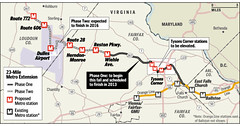Monocentric vs. polycentric transit planning in the DC region

Routing map, Silver Line WMATA. Map: Laris Karklis, Washington Post.
Yes, I subscribed to that WashDC_Metro elist yesterday and have been writing some stuff, including this:
ya gotta look at market segments. While the core capacity study did suggest parallel bus routes to address capacity issues, to me that is a strategy without a lot of legs, because buses don't have much capacity. You need a lot of buses to equal the passenger count for one 6 car or 8 car train.
The issue is between long trips and shorter trips. The people at the far ends have much different trip characteristics than the people who live close in. So, while the WMATA system is polycentric, promoting sprawl and suburbanization and further deconcentration of land use, at the core the subway system routing structure functions monocentrically.

Subway stations at the core of the city of Washington
Since responsibility for substantive planning has devolved to the jurisdictions, DC needs to take care of itself, in terms of planning for expansion at the core, because of coming capacity constraints.
Furthermore, DC shouldn't not have accepted the Silver Line expansion, because it was planned in a manner that disconnects its responsibility for impacts on the core of the system. Had this expansion been planned as a way to also bring the old separated blue line proposal back to life, along with an additional tunnel crossing, the Silver Line extension could have promoted outer suburban transportation objectives at the same time strengthening transportation needs and capacity in the core.
----------------
People will respond that transit is a regional issue that it isn't inherently competitive jurisdictionally, but that isn't the case, especially now that each major jurisdiction at the state level (Virginia and Maryland) initiates expansion planning. In this case, no fooling, DC needs to act like a state too.

(Sorry Dan...)
Given all the proposals for Metro expansion in Maryland (to BWI, in South Prince Georges, now even for Charles County, see "Cardin Talks Transit With Charles Officials" from the Post), DC needs to be more active in planning for expansion of the capabilities of the subway system in the core of the city--at the core of the system--as well as for railroad system planning--e.g., railroad service might be a better way to serve the transportation demands of Charles County residents traveling to the core of the region.
Labels: transportation planning



0 Comments:
Post a Comment
<< Home